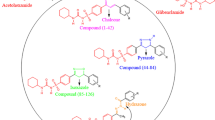Abstract
A comparative conformational analysis of cholesterol and ergosterol has been carried out using molecular mechanics methods. These studies are aimed at giving a better understanding of the molecular nature of the interaction of these sterols with polyene macrolide antibiotics. Structures of cholesterol and ergosterol determined by X-ray methods have been used as initial geometries of these molecules for force field calculations. The calculation of steric energy has also been made for conformations which do not appear in the crystal. The latter conformers have different conformations of the side chain as well as different conformations of rings A and D. The rotational barriers around bonds C17–C20 and C20–C22 have also been calculated. The results obtained on differences and similarities in the conformations of cholesterol and ergosterol allow us to postulate a mechanism for differential interaction with the antibiotics. The relatively rigid side chain of ergosterol (stretched molecule) in comparison with the flexible side chain of cholesterol (bent molecule), allows better intermolecular contact of the first sterol molecule with a polyene macrolide and in consequence facilitates complex formation involving Van der Waal's forces.
Similar content being viewed by others
References
Allinger NL (1977) Conformational analysis. 130. MM2. A hydrocarbon force field utilizing V1 and V2 torsional terms. J Am Chem Soc 99:8127–8134
Allinger NL, Sprague JT (1973) Calculation of the structures of hydrocarbons containing delocalized electronic systems by the molecular mechanics method. J Am Chem Soc 95:3893–3907
Allinger NL, Yuh YH (1980) Computer program MM2, University of Georgia, Athens (USA)
Allinger NL, Yuh YH (1982) Computer program MM2P, University of Georgia, Athens (USA)
Altona C, Geise HJ, Romers C (1968) Conformation of non-aromatic ring compounds — XXV. Geometry and conformation of ring D in some steroids from X-ray structure determinations. Tetrahedron 24:13–32
Bolard J (1986) How do the polyene macrolide antibiotics affect the cellular membrane properties? Biochim Biophys Acta 864:257–304
Clejan S, Bittman R (1985) Rates of Amphotericin B and filipin association with sterols. J Biol Chem 260:2884–2889
Cybulska B (1981) The role of structural factors in the modification of membrane permeability by polyene macrolide antibiotics. In: Proceedings of Sixth School on Biophysics of Membrane Transport (School Proceedngs, Poland), pp 124–149
Debouzy JC, Hervé M, Borowski E, Cybulska B, Neumann JM, Gary-Bobo CM (1988) Study by 31P, 13C NMR of the interaction of polyene antibiotics with sterols: antifungal selectivity. In: Proceedings of 2nd International Symposium on Molecular Aspects of Chemotherapy (Symposium Abstracts, Poland), pp 84
De Kruyff B, Demel RA (1974) Polyene antibiotic-sterol interactions in membranes of Acholeplasma laidlawii cells and lecithin liposomes. III. Molecular structure of the polyene antibiotic-cholesterol complexes. Biochim Biophys Acta 339:57–70
De Kruyff B, Gerritsen WJ, Oerlemans A, Demel RA, Van Deenen LLM (1974) Polyene antibiotic-sterol interactions in membranes of Acholeplasma laidlawii cells and lecithin liposomes. I. Specifity of the membrane pereability changes induced by the polyene antibiotics. Biochim Biophys Acta 339:30–40
Demel RA, De Kruyff B (1976) The function of sterols in membranes. Biochim Biophys Acta 457:109–132
Duax WL, Fronckowiak MD (1982) A comparison between crystallografic data and molecular mechanics calculations on the side chain and backbone conformations of steroids. In: Intramolecular Dynamics (Jerusalem Symp Quantum Chem Biochem). D Reidel, Dordrecht, pp 505–524
Duax WL, Griffin JF (1985) A comparison of crystallographic observations and molecular mechanics calculations of the conformations of steroids and steroids analogs. Stud Org Chem 20 (Nat Prod Chem): 385–396
Duax WL, Weeks CM, Rohrer DC (1976) Crystal structure of steroids. Top Stereochem 9:271–283
Duax WL, Griffin JF, Rohrer DC, Weeks CM (1980) Conformational analysis of sterols: comparison of X-ray crystallographic observations with data from other sources. Lipids 15:783–792
Dufourc EJ, Parish EJ, Chitrakorn S, Smith ICP (1984) Structural and dynamical details of cholesterol-lipid interaction as reveled by deuterium NMR. Biochemistry 23:6062–6071
Ganis P, Avitable G, Mechlinski W, Schaffner CP (1971) Polyene macrolide antibiotic amphotericin B. Crystal structure of the N-iodoacetyl derivative. J Am Chem Soc 93:4560–4564
Hervé M, Debouzy JC, Borowski E, Cybulska B, Gary-Bobo CM (1989) The role of the carboxyl and amino groups of polyene macrolides in their interactions with sterols and their selective toxicity. A 31P-NMR study. Biochim Biophys Acta 980:261–272
Hull SE, Woolfson MM (1976) The crystal structure of erosterol monohydrate. Acta Crystallogr B32:2370–2373
Kirk DN (1982) Physical methods. Terpenoids Steroids 11: 165–186
Kirk DN (1983) Physical methods. Terpenoids Steroids 12: 269–287
Kirk DN (1986) Steroids: Physical methods. Nat Prod Rep 3:505–513
Kotler-Brajtburg J, Price HD, Medoff G, Schlessinger D, Kobayashi GS (1974) Molecular basis for the selective toxicity of amphotericin B for yest and filipin for animal cells. Antimicrob Agents Chemother 5:377–382
Medoff G, Bolard J, Brajtburg J, Kobayashi GS (1983) Antifungal agents useful in therapy of systemic fungal infections. Ann Rev Pharmacol Toxicol 23:303–330
Nakamura T, Nishikawa M, Inoue K, Nojima S, Akiyama T, Sankawa U (1980) Phosphatidylcholine liposomes containing cholesterol analogues with side chains of various lengths. Chem Phys Lipids 26:101–110
Oldfield E, Chapman D (1972) Dynamics of lipids in membranes: heterogenity and the role of cholesterol. FEBS Lett 23:285–297
Romers C, Altona C, Jacobs HJC, De Graaff RAG (1974) Steroid conformations from X-ray analysis data. Terpenoids Steroids 4:531–583
Shieh HS, Hoard LG, Nordman CE (1981) The structure of cholesterol. Acta Crystallogr B37:1538–1543
Schneider HJ, Buchheit U, Gschwendtner W, Lonsdorfer M (1982) Steric distrotions and polar effects in steroids: molecular mechanics calculations and 13C-NMR-investigations. In: Mol Struct Biol Activity Proc. Meet. Elsevier, Amsterdam, pp 165–179
Stockton GW, Smith CP (1976) A deuterium nuclear magnetic resonance study of the condensing effect of cholesterol on egg phosphatidylcholine bilayer membranes. I. Perdeuterated fatty acid probes. Chem Phys Lipids 17:251–263
Teerlink T, De Kruyff B, Demel RA (1980) The action of pimaricin, etruscomycin and amphotericin B on liposomes with varying sterol content. Biochim Biophys Acta 599:484–492
Author information
Authors and Affiliations
Rights and permissions
About this article
Cite this article
Bagiński, M., Tempczyk, A. & Borowski, E. Comparative conformational analysis of cholesterol and ergosterol by molecular mechanics. Eur Biophys J 17, 159–166 (1989). https://doi.org/10.1007/BF00254770
Received:
Accepted:
Issue Date:
DOI: https://doi.org/10.1007/BF00254770




